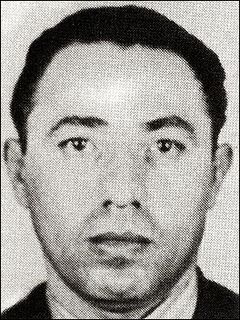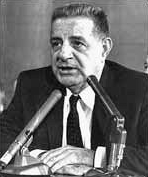
Charles Luciano, known as "Lucky Luciano", was an influential Italian-born mobster, criminal mastermind, and crime boss who operated mainly in the United States. Luciano is considered the father of modern organized crime in the United States for the establishment of the first Commission. He was also the first official boss of the modern Genovese crime family. Along with his associates, he was instrumental in the development of the National Crime Syndicate.

Giuseppe "Joe the Boss" Masseria was an early Italian-American Mafia boss in New York City. He was boss of what is now called the Genovese crime family, one of the New York City Mafia's Five Families, from 1922 to 1931. He waged a bloody war to take over the criminal activities in New York City, gaining considerable power for himself. He was killed in 1931 in a hit ordered by his own lieutenant, Charles "Lucky" Luciano.
The Castellammarese War was a bloody power struggle for control of the Italian-American Mafia, from February, 1930 to April 15, 1931, between partisans of Joe "The Boss" Masseria and those of Salvatore Maranzano. It was so called because Maranzano was based in Castellammare del Golfo, Sicily. Maranzano's faction won, and he declared himself capo di tutti capi, the undisputed leader of the entire Mafia. However, he was soon murdered in turn by a faction of young upstarts led by Lucky Luciano, who established a power-sharing arrangement called "The Commission", a group of five Mafia families of equal stature, to avoid such wars in the future.

The Genovese crime family is one of the "Five Families" that dominate organized crime activities in New York City and New Jersey as part of the Mafia. The Genovese crime family are rivaled in size only by the Gambino crime family and are unmatched in terms of power. They have generally maintained a varying degree of influence over many of the smaller mob families outside New York, including ties with the Philadelphia, Patriarca, and Buffalo crime families.

The Five Families are the five major New York City organized crime families of the Italian American Mafia.
See also: 1929 in organized crime, 1931 in organized crime and the list of 'years in Organized Crime'.
Tommy Lucchese was an Italian American gangster and founding member of the Mafia in the United States, an offshoot of the Cosa Nostra in Sicily. From 1951 until 1967, he was the boss of the Lucchese crime family, one of the Five Families that dominates organized crime in New York City.

Tommy Gagliano was an Italian American mobster and boss of what U.S. federal authorities would later designate as the Lucchese crime family, one of the "Five Families" of New York City. He served as a low-profile boss for over two decades. His successor was his longtime loyalist and underboss, Gaetano "Tommy" Lucchese.
See also: 1971 in organized crime, other events of 1972, 1973 in organized crime and the list of 'years in Organized Crime'.
Buster from Chicago was a pseudonym used for a mobster and freelance hitman of the 1930s. He is alleged to have played a key role in the Castellammarese War (1929–1931) as the assassin of Giuseppe Morello and others. Some claim that Buster was gangster Sebastiano Domingo (1910-1933), notably Bill Bonanno, the son of Bonanno crime family leader Joseph Bonanno, who participated in the War. Others charge that Buster is a character created by Joe Valachi to evade his responsibility for various killings.
Gaetano "Tommy" Reina was a Sicilian-born American gangster and founder of the Lucchese crime family in New York City.
The Valachi hearings, also known as the McClellan hearings, investigated organized crime activities across America and investigated leading mafia figures of the era such as Sam Giancana of Chicago. The hearings were initiated by Arkansas Senator John L. McClellan in 1963. The hearings were named after the major government witness against the American Mafia, Joseph Valachi.

The Lucchese crime family is one of the "Five Families" that dominate organized crime activities in New York City, United States, within the nationwide criminal phenomenon known as the Mafia.

The Valachi Papers is a biography written by Peter Maas, telling the true story of former mafia member Joe Valachi, a low-ranking member of the New York-based Genovese crime family, who was the first ever government witness coming from the American Mafia itself. His account of his criminal past revealed many previously unknown details of the Mafia. The book was made into a film, released in 1972, starring Charles Bronson as Valachi.
The kiss of death is the sign given by a mafioso boss or capo that signifies that a member of the crime family has been marked for death, usually as a result of some perceived betrayal. How much is based on fact and how much on the imagination of authors, it remains a cultural meme and appears in literature and films. Illustrative is the scene in the film The Valachi Papers when Vito Genovese gives the kiss of death to Joe Valachi to inform him that his betrayal of "the family" is known, and that he will be executed.

Albert Anastasia was an Italian-born American mobster, hitman and crime lord, and one of the most ruthless and feared organized crime figures in United States history. One of the founders of the modern American Mafia and the founder and boss of Murder, Inc., Anastasia was boss of what became the modern Gambino crime family. Anastasia is considered by the FBI to be one of the deadliest criminals of all time. According to former NYPD Detective Ralph Salerno, Anastasia murdered tens of thousands of people during his reign of terror, while former FBI Assistant Director James Kallstrom believes the number of people that Anastasia has killed is unquestionably in the thousands. The exact number is unknown. These claims are called into question by the fact that during prohibition the number of murders per year in New York City was around 500. To kill thousands Anastasia would have to have committed every murder in New York for several years.

















